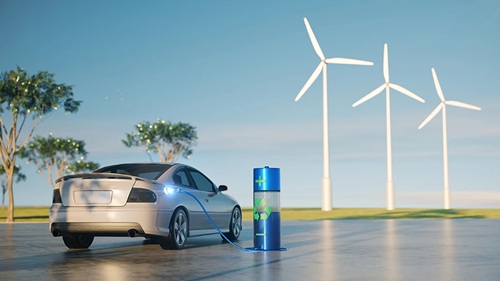India’s electric vehicle (EV) industry in 2025 stands at a decisive turning point — shifting from an early adoption phase to mainstream expansion. Backed by strong government incentives, a growing ecosystem of startups and OEMs, and a national commitment to carbon reduction, the EV sector is becoming one of India’s most transformative industrial stories.

Overview: A Fast-Accelerating Market
As of 2025, India’s EV industry is valued at approximately USD 8–10 billion, with projections suggesting a CAGR of 40–45% over the next decade. EV sales — including electric two-wheelers, three-wheelers, cars, and commercial vehicles — are expected to cross 1.8–2 million units in FY2025, reflecting growing consumer acceptance and better affordability.
The government’s ambitious target to achieve 30% electric mobility by 2030 is driving momentum across both private and public transportation sectors. India is now one of the world’s top five EV markets by volume, with strong participation from domestic players such as Tata Motors, Ola Electric, Ather Energy, Hero MotoCorp, and Mahindra Electric, alongside global giants like Hyundai, BYD, and MG Motor.
Policy Support: The Backbone of Growth
Government policy has been instrumental in shaping India’s EV ecosystem. The FAME II (Faster Adoption and Manufacturing of Electric Vehicles) scheme continues to provide incentives for EV buyers and subsidies for manufacturers. Additionally, the government’s Production-Linked Incentive (PLI) scheme for Advanced Chemistry Cell (ACC) batteries, worth ₹18,100 crore, has attracted significant investment in domestic battery manufacturing.
Key initiatives powering the industry in 2025 include:
- FAME II Extension (2024–26): Revised with higher subsidies for two- and three-wheelers to accelerate adoption.
- National Electric Mobility Mission Plan (NEMMP): Promotes EV infrastructure, R&D, and component localization.
- State EV Policies: States like Delhi, Maharashtra, Tamil Nadu, and Gujarat have introduced their own EV policies offering tax rebates, registration fee waivers, and capital support for manufacturers.
- Battery Swapping and Recycling Framework: Introduced to ensure sustainability and reduce costs for fleet operators.
These initiatives have made India a more attractive destination for EV manufacturing and foreign investment.
Segment-Wise Performance in 2025
- Two-Wheelers: The largest EV segment, accounting for nearly 55–60% of total EV sales. Brands like Ola Electric, Ather, TVS, and Bajaj dominate the market. Prices are becoming competitive with ICE (internal combustion engine) models due to battery cost reductions and local assembly.
- Three-Wheelers: A major driver of EV adoption, especially in last-mile delivery and urban transport. E-rickshaws and e-loaders are now a common sight in Tier-II and Tier-III cities.
- Passenger Vehicles: Growing steadily with Tata Motors leading the charge through its Nexon EV and Tiago EV models. MG Motor, Mahindra, and BYD are also expanding portfolios to meet rising urban demand.
- Commercial Vehicles: Early-stage adoption but promising potential. Companies like Eicher, Ashok Leyland, and JBM Auto are investing in e-buses and electric trucks for public transport and logistics.
Battery and Charging Infrastructure: The Next Frontier
In 2025, battery costs have fallen below USD 120/kWh, improving EV affordability. India’s focus on localized battery production and the setup of gigafactories in states like Gujarat, Tamil Nadu, and Karnataka are strengthening supply chain resilience.
The charging infrastructure has also expanded rapidly. India now has over 12,000 public charging stations, with major networks built by Tata Power, Statiq, ChargeZone, and Shell Recharge. The rollout of fast-charging corridors along highways and battery-swapping networks in metros is reducing range anxiety — a key adoption barrier.
Private Investment and Start-Up Ecosystem
The EV sector has become a magnet for venture capital and corporate investment. Between 2020 and 2024, India’s EV startups raised over USD 3 billion in funding. In 2025, continued investor confidence is fueling new ventures in battery technology, charging networks, fleet electrification, and recycling.
Manufacturing investments are also rising — Tata Motors, Ola Electric, and Hyundai have announced new EV plants and R&D centers, while Tesla is reportedly exploring local assembly under the Make in India framework. This blend of local innovation and global expertise is accelerating technology transfer and job creation.
Challenges: The Roadblocks Ahead
Despite the strong growth trajectory, the EV industry faces structural challenges:
- High upfront costs: Though operating costs are low, the initial purchase price remains higher than ICE vehicles.
- Battery supply chain dependency: India still imports key materials like lithium and cobalt.
- Charging gaps: Rural and highway infrastructure is still underdeveloped.
- Recycling and disposal: Battery waste management and standardization are emerging issues.
Addressing these gaps through policy, research, and investment will be crucial for sustainable expansion.
The Road Ahead: Toward an Electrified Future
By the end of 2025, India’s EV revolution is not just about replacing petrol engines with electric motors — it’s about reimagining mobility as cleaner, smarter, and more inclusive. The convergence of EVs, renewable energy, and digital technology is creating a new industrial ecosystem that aligns with India’s Net Zero 2070 vision.
With the right policy continuity, infrastructure development, and consumer awareness, India could emerge as the third-largest EV market globally by 2030, behind only China and the U.S.
Conclusion: A New Era of Mobility
The EV industry in India in 2025 is a powerful example of how innovation, policy, and sustainability can converge to reshape an entire sector. What began as a niche movement is now a national mission — powering employment, industrialization, and climate resilience.
As electric mobility gains mass traction, India’s journey from fuel dependency to energy independence is well underway. The road to 2030 will be challenging, but the direction is clear: India’s future is electric.

